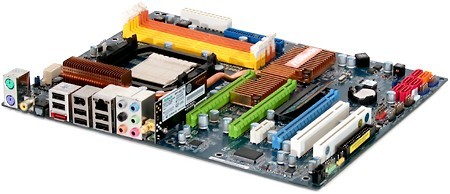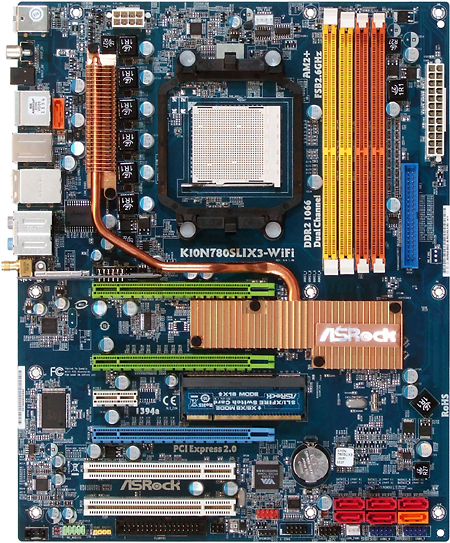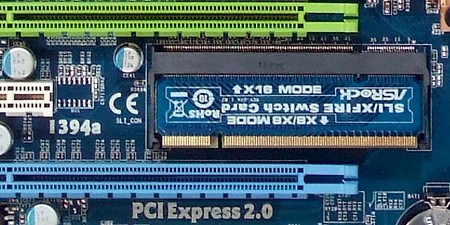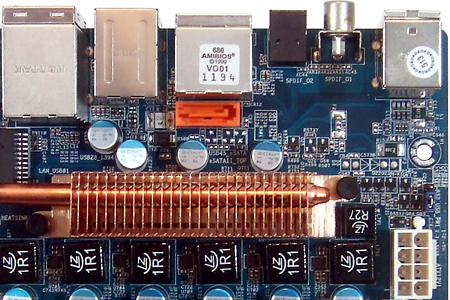NFORCE 780a SLI Motherboard Comparison
ASRock K10N780SLIX3-WiFi
As a spin-off of Asus, ASRock motherboards often includes design features formerly found in Asus products, but with a different market focus and naming scheme.

Layout and Features
Targeting budget-minded enthusiasts, the K10N780SLIX3-WiFi focuses on performance and compatibility rather than excessive features. The long name is nothing to be scared of, as it aptly describes the motherboard’s support for “K10” AMD Phenom processors, using 780a SLI chipset with 3-way SLI capability, plus a built-in WiFi adapter.

The appearance of an old-fashioned “Paddle Card” PCI-Express mode selector between the second and third x16 slots seems out of place on a modern enthusiast board, but is much less costly to implement than the automatic switching devices found on more elaborate designs. A total of thirty-two PCI-Express 2.0 pathways can be divided as two x16 pathways or, for 3-way SLI mode, a single x16 plus two x8 pathways. Rather than being disabled, the third x16 slot drops to x1 mode when the paddle card is set to deliver all 32 PCI-Express 2.0 pathways to the first two slots.

The K10N780SLIX3-WiFi spaces each x16 interface two slots apart for adequate clearance of double-slot graphics coolers, leaving the space between the first and second x16 slot empty. Users will need at least a single graphics card simply to use the board, so the empty slot position is no loss to most builders. A single x1 interface beneath the second x16 slot would be blocked by the graphics cooler of any double-slot card, and 3-way SLI configurations will leave the system with only a single PCI slot for further expansion.
ATA connections are simplified by an Ultra ATA header near the top of the K10N780SLIX3-WiFi’s front edge and SATA 3.0GB/s connections in the lower front corner. These should have no problem clearing oversized graphics coolers on super-long cards, and are ideally placed for typical tower cases that have 5.25” external bays at the top and 3.5” internal bays at the bottom.
The placement of other data interfaces isn’t so thoughtful: The front panel audio connector is found in the “traditional” lower rear corner, and the floppy connector is crammed beneath the lowest PCI slot. The audio connector placement is a tradition we’d love to see go away, since most cases now have front panel jacks at the opposite corner. Also, routing a floppy drive’s wide ribbon cable to a front bay could be very difficult, and this is a problem still faced by Windows XP users who need to load RAID drivers.

The orange SATA connector near the top of the K10N780SLIX3-WiFi’s rear edge at first appears to be a remnant of bygone Asus design, but this isn’t actually a port! Because the K10N780SLIX3-WiFi lacks any third-party controllers for adding eSATA, ASRock instead provides a top-side SATA to rear-panel eSATA pass-through connection. Enabling the eSATA port requires the builder to run an SATA cable diagonally across the board, from the orange SATA port in the lower front corner to the SATA pass-through connector at the top rear corner.
Get Tom's Hardware's best news and in-depth reviews, straight to your inbox.
Current page: ASRock K10N780SLIX3-WiFi
Prev Page A Scooter with a Rocket Engine? Next Page Onboard Devices-
a 6pack in so after reading all this.. i think im stickin with my 790FX. i was waiting for a quite a while for nvidia to pull something here with the 780a chipset. In my eyes its a fail.Reply
AMD's 790FX chipset provides significantly more lanes than nvidia. 3-way SLI is a novel idea but at x8 lanes for 3 slots.. not so much. while amd is providing full x16 support.
good info tho. if anything i would recommend the ASRock board also for nvidia's SLI path. -
johnbilicki I wan to see boards with two 16x slots and one 4x slot. Honestly I'm not interested in 100+ FPS at 1024x768 or 1280x1024 which is what you'll get in most games with triple SLI. The MSI board looks like they could have fit a couple more USB ports next to the useless firewire port. It's 2008 and I have yet to even see a product require a firewire port on products I'm only browsing on sales sites like Newegg or even just review sites. I liked Gigabyte's new quad gigabit port motherboard, finally 8 USB ports on the back! Also if no one shows up with a router at your LAN party three of your buddies can merely connect to your system any way (and who doesn't have dual LAN ports these days besides your cheap who cheaps out by five bucks on a north bridge).Reply
What is with the waste of brackets? Give us four USB ports on a bracket. If you upgrade even only once every four or five years you probably still have about five or six brackets laying around somewhere with all the firewire ports you could ever want...and if not your buddies do.
The dual-slot coolers on single slot cards, what a waste! If you're going to use a second slot don't waste the opportunity to move that hot air the heck out of the case!
My last criticism is the i-ram...DDR-1?! I love Gigabyte when it actually bothers to make boards using chipsets I'd want (they skipped the true 16X SLI and jumped on the then useless AM2 bandwagon however). So why aren't we seeing DDR2 RAM-drives? 4x4GB/32GB would be far out of most people's budgets but a 4x2GB/16GB RAM drive at $40/$160 dimm/total would *own* a raptor raid 0 any day in price/performance.
The manufacturers need to seriously start bringing some people in to the design rooms to question WTF they're thinking with their product designs because I see no reason to bother spending any money right now.
...and to clarify I enjoyed the article itself, it's just the products I hold disappointment in. The new chipset is great overall though. -
nukemaster DDR is still faster then any hard drive interface anyway(DDR 266 @ 2128MB/s), so why not? its actually limited by its sata 150 interface not the ram(it would also max sata 300).Reply
I agree DDR2 is the way to go, but only because the price is much lower and better capacities. When gigabyte designed the I-ram ddr was cheaper and ddr2 was new and expensive.
I think there is a DDR2 I-ram in the making -
I own an evga 780i and I am plagued with the video corruption problem like many other nvidia 7 series owners. BEWARE before you invest on these boards. Nvidia hasn't released a fix in 3 months. Many people can't watch video or play games without encountering a hard lock-up.Reply
Video of problem: http: //www. youtube. com/watch?v=TYHuzJSpORw
http: //www.evga. com/forums/tm.asp?m=253891&mpage=1&key=
http: //nvidia.custhelp. com/cgi-bin/nvidia.cfg/php/enduser/std_adp.php?p_faqid=2190
http: //vip.asus. com/forum/view.aspx?id=20080407161030625&board_id=1&model=Striker+II+Formula&page=1&SLanguage=en-us
http: //forums.anandtech.com/messageview.aspx?catid=31&threadid=2178960&FTVAR_STKEYWORDFRM=&STARTPAGE=1&FTVAR_FORUMVIEWTMP=Linear
http: //digg. com/hardware/780i_nvidia_motherboard_graphics_corruption -
jabliese No comparison of just the integrated graphics? One of the selling points for the 790 is it's DX10 support, would like to see some kind of comparison between just the integrated graphics, say, maybe on HDTV playback.Reply -
unifiedonboarddecoder They should also do the test using an ATi video card. I would like to see those benchmarks as well.Reply
